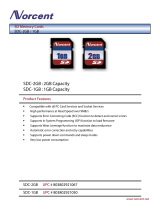
- 4 -
e. Select path to store the disk
f. Click OK
7. (Optional) Adjust your SDC instance to use proper resource
configurations based on the following sizing table or using default
settings (8 CPU cores, 16 GB of memory). Click Edit virtual
machine settings.
Sizing Table
a. Click Edit virtual machine settings.
b. Configure the amount of memory.
c. Configure the number of CPU cores.
8. (Optional) Change the network adapter setting from ‘NAT’ to
‘Bridged’.
a. Right click the SDC VM icon and select Settings.
b. Select Network Adapter and change the default setting from
[NAT] to [Bridged] if necessary.
9. Boot the SDC VM, and the SDC instance will start.
System Migration
When a new version of SDC is released, the settings of the old SDC can be
migrated by attaching the external disk of the old SDC to the new SDC VM.
The settings that will be migrated to the SDC includes:
• The UUID of the old SDC. (To ensure all virtual machines are
identified properly, each virtual machine is automatically assigned a
universal unique identifier (UUID).)
• The pattern and firmware downloaded by the old SDC.
• The system configuration set from the old SDC including its license,
accounting information, security policies, and so on.
• The security event logs stored by the old SDC.
Procedure
1. Launch the new instance of SDC. (For more details, see “Deploying
Security Dashboard Console” under the “Installing SDC on a VMware
Workstation”.)
2. Power off the old SDC
3. Attach the external disk of the old ODC to the new SDC.















